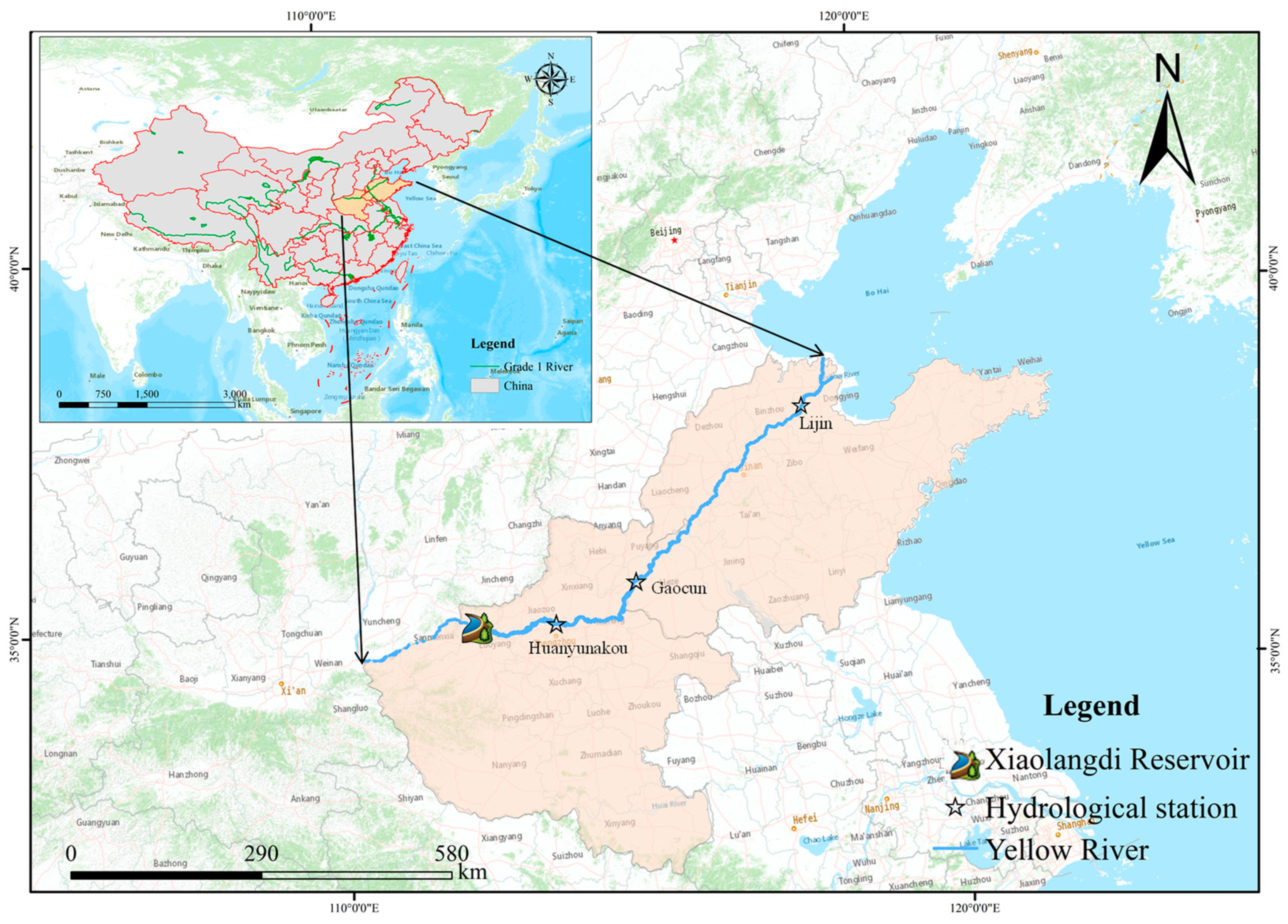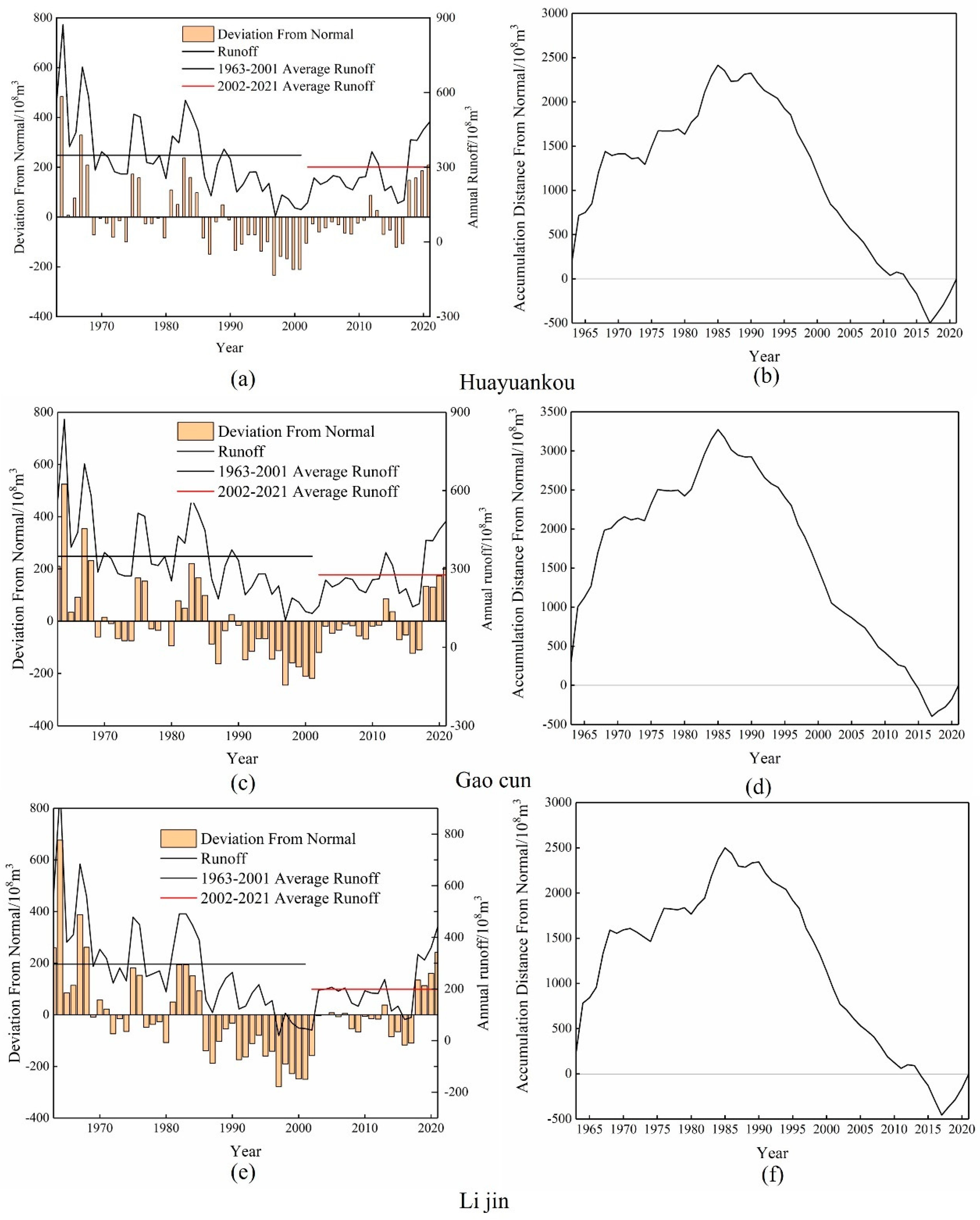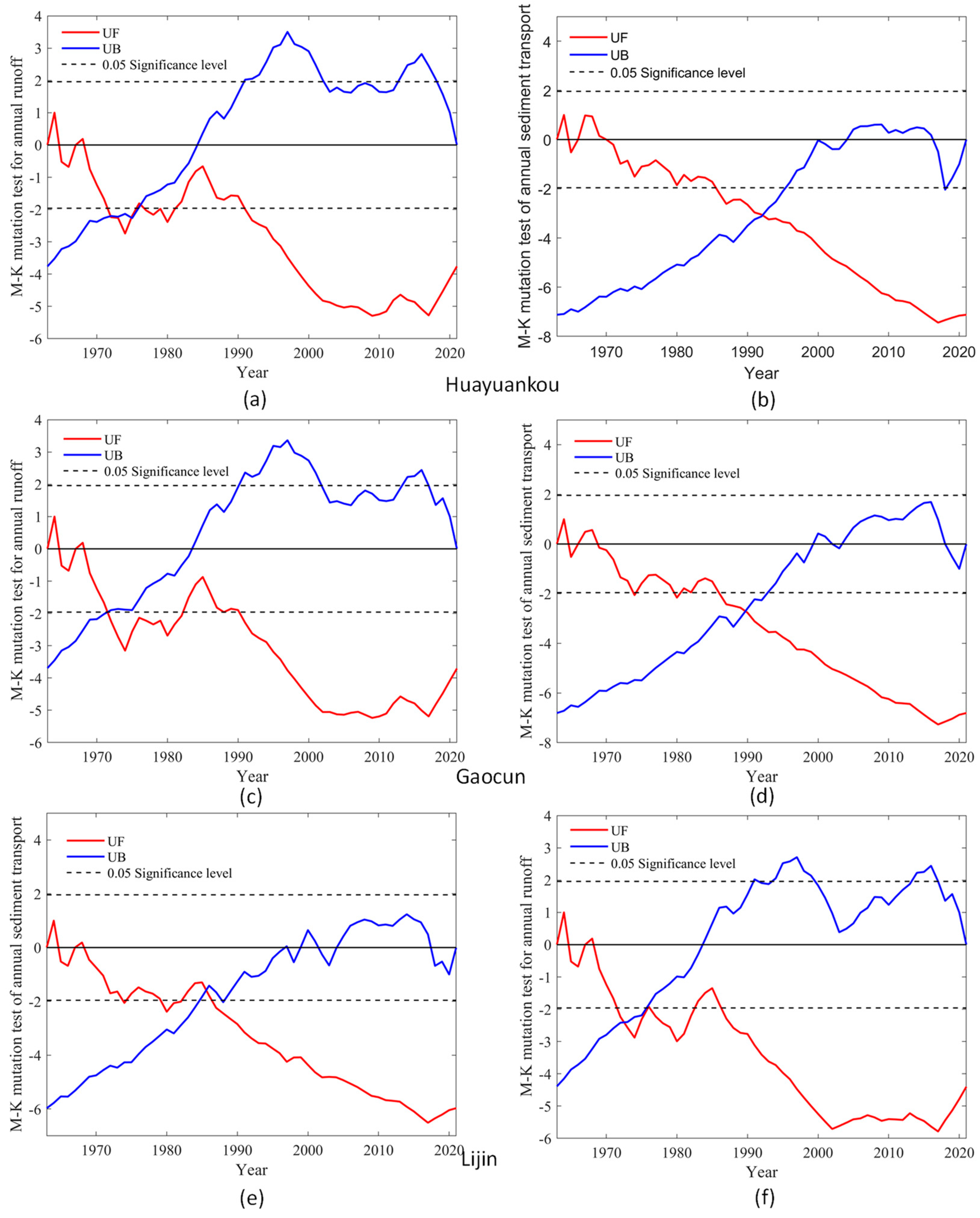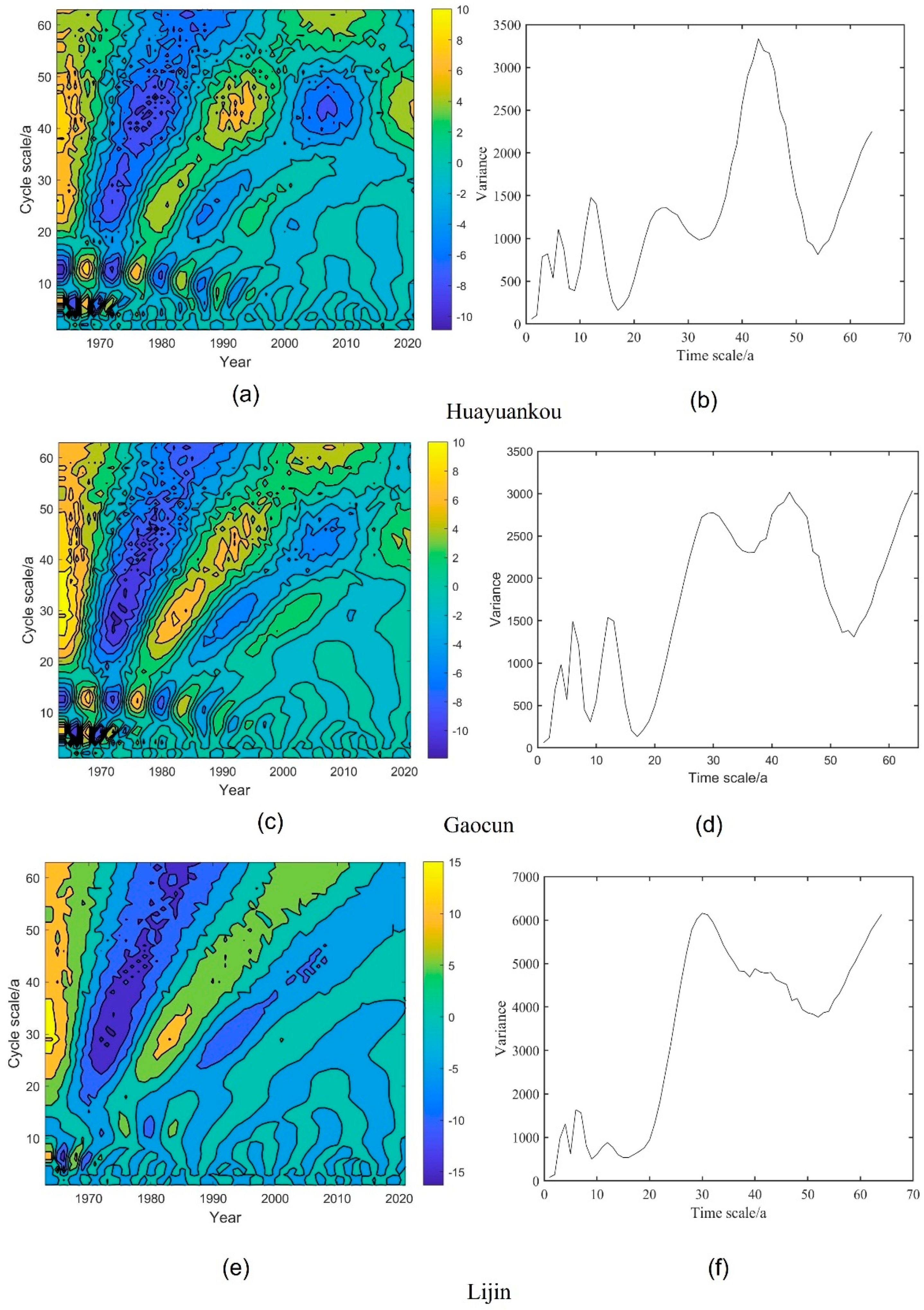Quantitative Analysis of the Influence of the Xiaolangdi Reservoir on Water and Sediment in the Middle and Lower Reaches of the Yellow River
Abstract
1. Introduction
2. Study Area and Data Source
3. Research Methods
3.1. Unevenness Coefficient
3.2. Cumulative Anomaly
3.3. Two-Sample F-Test
3.4. Mann-Kendall Test
3.5. Continuous Wavelet Analysis
4. Analysis and Discussion
4.1. Interannual Runoff Analysis
4.2. Intra-Annual Runoff Characterization
4.3. Characterization of Sediment Transport Volume
4.4. Analysis of Sudden Changes in Runoff and Sediment Transport
4.5. Periodic Analysis of Runoff and Sediment Transport
5. Conclusions
- (1)
- On the interannual scale, the operation of the Xiaolangdi Reservoir has a limited impact on interannual runoff and a significant impact on sediment transport. The annual runoff at Huayuankou, Gaocun, and Lijin stations decreased by 20.1%, 20.39%, and 32.87%, respectively, and the sediment transport decreased by 90.03%, 85.34%, and 83.88%, respectively. The closer to the mouth of the Yellow River, the greater the rate of reduction in runoff and the smaller the rate of reduction in sediment transport.
- (2)
- On the intra-annual scale, the impact of the Xiaolangdi Reservoir on runoff is greater. Regulates the distribution of runoff during the year, mainly by cutting peak runoff, reducing runoff during the abundant period, and increasing runoff during the dry period. The ratio of runoff during the abundant water period to the whole year was reduced, and the ratio of abundant water period to the whole year was reduced from 54.29%, 54.93%, and 60.72% to 41.41%, 43.66%, and 55.49% at Huayuankou station, Takamura Station, and Lijin Station. The timing of the maximum flow occurring during the year was also changed, with the maximum flow occurrence being adjusted from September to June and July.
- (3)
- The Mann-Kendall test shows that the tributaries of the middle and lower reaches of the Yellow River do not have a significant impact on interannual runoff. The overall runoff and sediment transport in the middle and lower Yellow River from 1963 to 2021 shows a decreasing trend with abrupt and unsynchronized changes. The operation of the Xiaolangdi Reservoir has mitigated this downward trend to some extent.
- (4)
- By wavelet analysis, the runoff cycles in the middle and lower reaches of the Yellow River are runoff cycles 58a, 43a, 32a, 12a, 8a, and 3a, and the main cycles are 43a and 32a; the sediment transport cycles are runoff cycles of 43a, 28a, 15a, 8a, 3a, and the main cycles are 43a and 28a. The operation of the Xiaolangdi Reservoir has changed the main cycle of annual runoff to some extent, causing the disappearance of the second main cycle, but the effect on the main cycle of sediment transport is not significant, and the cycle is less pronounced the closer it is to the mouth of the sea. The contours of the larger values of the main cycle of runoff and sediment transport did not close, indicating that runoff and sediment transport will increase next.
Author Contributions
Funding
Institutional Review Board Statement
Informed Consent Statement
Data Availability Statement
Conflicts of Interest
References
- Ma, Z.Z.; Wang, Z.J.; Xia, T. Hydrograph-based hydrologic alteration assessment and its application to the Yellow River. J. Environ. Inform. 2014, 23, 1–13. [Google Scholar] [CrossRef]
- Bunn, S.E.; Arthington, A.H. Basic principles and ecological consequences of altered runoff regimes for aquatic biodiversity. Environ. Manag. 2002, 30, 492–507. [Google Scholar] [CrossRef] [PubMed]
- Zhang, J.; Dong, Z.R.; Sun, D.Y. Complete river health assessment index system based on eco-regional method according to dominant ecological functions. J. Hydraul. Eng. 2010, 41, 883–892. (In Chinese) [Google Scholar]
- Poff, N.L. Beyond the natural runoff regime Broad-ening the hydro-ecological foundation to meet environmental flows challenges in a non-stationary world. Freshw. Biol. 2018, 63, 1011–1021. [Google Scholar] [CrossRef]
- Dong, Z.R.; Zhang, J.; Zhao, J.Y. Comments upon progress of environmental flows assessments. J. Hydraul. Eng. 2017, 48, 670–677. (In Chinese) [Google Scholar]
- Poff, N.L.; Richter, B.D.; Arthington, A.H. The ecological limits of hydrologic alteration (ELOHA): A new framework for developing regional environmental flow standards. Freshw. Biol. 2010, 55, 147–170. [Google Scholar] [CrossRef]
- Pang, L.M. Number of Dams in the World China Power Grid. 1 March 2021. Available online: http://www.chinapower.com.cn/qtsj/20210301/54829.html (accessed on 1 March 2021).
- Wang, Y.; Wang, D.; Wu, J. Assessing the impact of Danjiangkou reservoir on ecohydrological conditions in Hanjiang river, China. Ecol. Eng. 2015, 81, 41–52. [Google Scholar] [CrossRef]
- Poff, N.L.; Schmidt, J.C. How dams can go with the flow. Science 2016, 353, 1099–1100. [Google Scholar] [CrossRef]
- Poff, N.L.; Olden, J.D. Can dams be designed for sustainability? Science 2017, 358, 1252–1253. [Google Scholar] [CrossRef]
- Ngor, P.B.; Legendre, P.; Oberdorffb, T. Flow alteration by dams shaped fish assemblage dynamics in the complex Mekong-3s river system. Ecol. Indic. 2018, 88, 103–114. [Google Scholar] [CrossRef]
- Chen, X.X.; Ye, S.; Pan, H.L. Analysis of the impact of reservoir operation on the hydrological situation of rivers—Longyangxia and Xiaolangdi reservoirs as examples. China Rural Water Conserv. Hydropower 2022, 10, 96–104. [Google Scholar]
- Williams, G.P.; Gordon, W.M. Downstream Effects of Dams on Alluvial Rivers; Usgs Professional Paper; US Government Printing Office: Washington, DC, USA, 1984; 1286. [CrossRef]
- Walling, D.E.; Fang, D. Recent trends in the suspended sediment loads of the world’s rivers. Glob. Planet. Change 2003, 39, 111–126. [Google Scholar] [CrossRef]
- Vorosmarty, C.J.; Meybeck, M.; Fekete, B. The potential impact of neo-cauterization on sediment transport by the global network of rivers. In Human Impact on Erosion and Sedimentation(Proc Rabat Symposium. April 1997); IAHS Publication No 245; IAHS Press: Wallingford, UK, 1997; pp. 261–273. [Google Scholar]
- Song, X.; Zhuang, Y.; Wang, X. Analysis of Hydrologic Regime Changes Caused by Dams in China. Hydrol. Eng. 2020, 25, 05020003. [Google Scholar] [CrossRef]
- LI, Y.; Chang, J.; Tu, H. Impact of the Sanmenxia and Xiaolangdi Reservoirs operation on the hydrologic regime of the lower Yellow River. J. Hydrol. Eng. 2016, 21, 6015015. [Google Scholar] [CrossRef]
- Kong, D.X.; Latrubesse, E.M.; Miao, C.Y. Morphological response of the Lower Yellow River to the operation of Xiaolangdi Reservoir, China. Geomorphology 2020, 350, 106931. [Google Scholar] [CrossRef]
- Shang, H.X.; Zheng, Y.S.; Zhang, X.H. Effects of reservoir utilization on water and sediment conditions in the Ningmeng River. People’s Yellow River 2008, 30, 28–30. [Google Scholar]
- Miao, C.Y.; Kong, D.X.; Wu, J.W. Functional degradation of the water-sediment regulation scheme in the lower Yellow River: Spatial and temporal analyses. Sci. Total Environ. 2016, 551–552, 16–22. [Google Scholar] [CrossRef]
- Wang, Y.J.; Wu, B.S.; Zhong, D.Y. Simulating cross-sectional geometry of the main channel in response to changes in water and sediment in Lower Yellow River. J. Geogr. Sci. 2020, 30, 2033–2052. [Google Scholar] [CrossRef]
- Kong, D.X.; Miao, C.Y.; Wu, J.W. The hydro-environmental response on the lower Yellow River to the water-sediment regulation scheme. Ecol. Eng. 2015, 79, 69–79. [Google Scholar] [CrossRef]
- Hu, C.H.; Chen, J.G.; Guo, Q.C. Regulation of water and sediment processes in the Yellow River and shaping of the downstream channel in the water channel. J. Tianjin Univ. 2008, 41, 1035–1040. [Google Scholar]
- Li, M.C.; Hu, C.H. Multi-timescale analysis of water-sediment and flatland flow in the lower Yellow River. J. China Inst. Water Res. Hydropower Res. 2012, 10, 166–173. [Google Scholar]
- Zhang, Y.Y.; Zhong, D.Y.; Wu, B.S. Multi-timescale phenomena of runoff in the Yellow River Flats. Adv. Water Sci. 2012, 23, 302–309. [Google Scholar]
- Liu, X.Y.; Ma, S.Y.; Dang, S.Z. Changes in sediment production situation in the Yellow River basin in the past 100 years. Sedim. Res. 2017, 5, 1–6. [Google Scholar]
- Liu, X.Y.; Gao, Y.F.; Ma, S.B. Sediment reduction effect of silt dams on the Loess Plateau and their temporal effects. J. Water Res. 2018, 49, 145–154. [Google Scholar]
- Zhou, Y.Y.; Huang, H.Q.; Ran, L.S. Hydrological controls on the evolution of the Yellow River Delta: An evaluation of the relationship since the Xiaolangdi Reservoir became fully operational. Hydrol. Process. 2018, 32, 3633–3649. [Google Scholar] [CrossRef]
- Li, J.; Chu, M.H.; Zhang, Y.; Zhu, C.H. Characteristics of the evolution of continental beaches in the wandering section of the lower Yellow River from 1986–2018. People’s Yellow River. 2022, 44, 51–55. [Google Scholar]
- Esri. “Topographic” [Basemap]. Scale Not Given. “World Topographic Map”. 19 February 2012. Available online: http://www.arcgis.com/home/item.html?id=30e5fe3149c34df1ba922e6f5bbf808f (accessed on 25 May 2017).
- Wang, Y.J.; Wu, B.S.; Zhong, D.Y. Adjustment in the main-channel geometry of the lower Yellow River before and after the operation of the Xiaolangdi Reservoir from 1986 to 2015. J. Geogr. Sci. 2020, 30, 468–487. [Google Scholar] [CrossRef]
- Tang, Q.C.; Li, X.Y. Calculation and discussion on the non-uniform coefficient of annual runoff distribution. Res. Sci. 1982, 03, 59–65. [Google Scholar]
- Wang, H.X.; Zhao, Y.Y.; Liu, J.H. Water and sediment regime evolution and its influencing factors in the Lower Yellow River in recent 50 years. J. Hydroel. Power 2020, 46, 48–54. (In Chinese) [Google Scholar]
- He, W.; Bu, R.C.; Xiong, Z.P. Variation trend of temperature and precipitation in Northeast China during 1961–2005. Acta Ecol. Sin. 2013, 33, 519–531. [Google Scholar] [CrossRef]
- Xue, J.; Xia, Z.Q.; Huang, F. Influence of large reservoirs on interannual variation and annual distribution of downstream river runoff. Hydropower Energy Sci. 2013, 31, 17–20. [Google Scholar]
- Chen, Y.B.; Zhang, X.; Yang, W.F. Influence on river runoff quantitative analysis of construction operation of cascade reservoirs. People’s Yangtze River 2021, 52, 116–123. [Google Scholar]
- Liu, C.M.; Wang, K.W.; Wang, M. Runoff and its influencing factors in the Yellow River Basin from 1956 to 2016. People’s Yellow River 2022, 44, 1–5. [Google Scholar]
- Chong, K.L.; Huang, Y.F.; Koo, C.H. Spatiotemporal variability analysis of standardized precipitation indexed droughts using wavelet transform. J. Hydrol. 2022, 605, 127299. [Google Scholar] [CrossRef]
- Zhang, J.P.; Xiao, H.L.; Fang, H.Y. Component-based Reconstruction Prediction of Runoff at Multi-time Scales in the Source Area of the Yellow River Based on the ARMA Model. Water Res. Manag. 2022, 36, 433–448. [Google Scholar] [CrossRef]
- Labat, D. Recent advances in wavelet analyses: Part 1. A review of concepts. J. Hydrol. 2005, 314, 275–288. [Google Scholar] [CrossRef]
- Zhang, H.B.; Huang, Q.; Zhang, Q. changes in the long-term hydrological regimes and the impacts of human activities in the main Wei River, China. Hydrol. Sci. 2016, 61, 1054–1068. [Google Scholar] [CrossRef]
- Anuragi, A.; Singh, S.D. EEG-based cross-subject emotion recognition using Fourier-Bessel series expansion based empirical wavelet transform and NCA feature selection method. Inf. Sci. 2022, 610, 508–524. [Google Scholar] [CrossRef]
- Yao, W.Y.; Gao, Y.J.; An, C.H. Trend analysis of 100-year scale water and sediment variation in the upper and middle reaches of the Yellow River. Adv. Water Res. Hydropower Sci. Technol. 2015, 35, 112–120. [Google Scholar]
- Yu, L.; Wang, G.H.; Zou, Z.K. Adjustment pattern of riverbed cross-sectional morphology in the Shashi River section of the Upper Jingjiang River. J. River Sea Univ. 2016, 44, 544–549. [Google Scholar]
- Wang, W.S.; Ding, J.; Xiang, H.L. Wavelet transform method for multi-time scale analysis of hydrological time series. J. Sichuan Univ. 2002, 34, 14–17. [Google Scholar]
- Li, Z.H.; Wang, H.; Han, G.D. Progress in the study of the Yellow River downstream flow break. Ecol. Environ. 2007, 02, 686–690. [Google Scholar]
- Shang, W.X.; Peng, S.M.; Wang, Y. Analysis of the impact of Xiaolangdi hydrological hub on the ecology of the lower reaches of the Yellow River. Water Res. Conserv. 2022, 38, 160–166. [Google Scholar]
- Guo, Q.C.; Hu, C.H.; Cao, W.H. Desilting effect of large reservoirs in the middle and lower reaches of the Yellow River on the downstream river channel. J. Water Res. 2005, 05, 511–518. [Google Scholar]









| Site | Year | Average Value/108 m3 | Nonuniform Coefficient | Distance from Mean/% |
|---|---|---|---|---|
| Huayuankou station | 1963–1969 | 550.03 | 0.32 | 322.55 |
| 1970–1979 | 380.73 | 0.23 | 11.15 | |
| 1980–1989 | 412.77 | 0.28 | 96.24 | |
| 1990–1999 | 256.88 | 0.23 | −317.77 | |
| 2000–2009 | 231.57 | 0.17 | −384.98 | |
| 2010–2019 | 303.54 | 0.31 | −193.85 | |
| 2020–2021 | 498.40 | 0.02 | 64.73 | |
| 1963–2001 | 376.53 | 0.41 | 7.31 | |
| 2002–2021 | 300.86 | 0.33 | −14.26 | |
| 1963–2001 | 350.88 | 0.40 | ||
| Gaocun station | 1963–1969 | 546.30 | 0.34 | 479.34 |
| 1970–1979 | 352.57 | 0.24 | 87.31 | |
| 1980–1989 | 373.90 | 0.31 | 153.09 | |
| 1990–1999 | 222.99 | 0.28 | −312.31 | |
| 2000–2009 | 211.15 | 0.23 | −348.83 | |
| 2010–2019 | 276.69 | 0.32 | −146.70 | |
| 2020–2021 | 467.10 | 0.03 | 88.10 | |
| 1963–2001 | 348.34 | 0.46 | 7.43 | |
| 2002–2021 | 277.31 | 0.34 | −14.48 | |
| 1963–2001 | 324.26 | 0.45 | ||
| Lijin station | 1963–1969 | 550.03 | 0.38 | 765.75 |
| 1970–1979 | 311.22 | 0.27 | 184.79 | |
| 1980–1989 | 305.40 | 0.45 | 162.64 | |
| 1990–1999 | 140.76 | 0.48 | −464.15 | |
| 2000–2009 | 141.14 | 0.47 | −462.69 | |
| 2010–2019 | 186.20 | 0.44 | −291.16 | |
| 2020–2021 | 400.35 | 0.10 | 104.82 | |
| 1963–2001 | 296.36 | 0.65 | 12.82 | |
| 2002–2021 | 198.96 | 0.49 | −24.26 | |
| 1963–2001 | 262.68 | 0.66 |
| Site | 1963–2021 | 1963–2001 | 2002–2021 | ||||||
|---|---|---|---|---|---|---|---|---|---|
| Zc | Judgment | Trend | Zc | Judgment | Trend | Zc | Judgment | Trend | |
| Huayuankou station | −3.75 | |Zc| > 2.32 | - | −4.6 | |Zc| > 2.32 | - | 1.98 | |Zc| < 2.32 | + |
| Gaocun station | −3.69 | |Zc| > 2.33 | - | −4.83 | |Zc| > 2.33 | - | 1.85 | |Zc| < 2.33 | + |
| Lijin station | −4.39 | |Zc| > 2.34 | - | −5.46 | |Zc| > 2.34 | - | 0.94 | |Zc| < 2.34 | + |
| Site | F | F1-a/2 | Fa/2 | Conclusion |
|---|---|---|---|---|
| Huayuankou station | 0.50 | 0.39 | 3.85 | Acceptance |
| Gaocun station | 2.83 | 0.39 | 3.85 | Acceptance |
| Lijin station | 3.85 | 0.39 | 3.85 | Acceptance |
| Month | Huayuankou Station | Gaocun Station | Lijin Station | ||||||
|---|---|---|---|---|---|---|---|---|---|
| 1963–2001 (1) | 2002–2021 (2) | (1)–(2) | 1963–2001 (3) | 2002–2021 (4) | (3)–(4) | 1963–2001 (5) | 2002–2021 (6) | (5)–(6) | |
| January | 3.82 | 3.88 | −0.06 | 3.64 | 3.75 | −0.11 | 4.05 | 3.66 | 0.38 |
| February | 3.69 | 4.62 | −0.93 | 3.40 | 4.06 | −0.66 | 3.32 | 2.92 | 0.40 |
| March | 7.06 | 8.00 | −0.94 | 6.54 | 7.58 | −1.04 | 4.63 | 3.01 | 1.63 |
| April | 7.08 | 8.44 | −1.36 | 6.73 | 8.04 | −1.31 | 4.64 | 4.14 | 0.50 |
| May | 6.61 | 8.16 | −1.54 | 6.11 | 7.67 | −1.55 | 4.46 | 6.23 | −1.77 |
| June | 5.33 | 13.85 | −8.52 | 5.23 | 13.24 | −8.01 | 3.87 | 12.13 | −8.27 |
| July | 10.79 | 12.85 | −2.07 | 11.74 | 14.03 | −2.29 | 10.42 | 18.22 | −7.80 |
| August | 15.03 | 9.27 | 5.76 | 17.17 | 9.78 | 7.39 | 16.62 | 13.43 | 3.19 |
| September | 15.78 | 9.70 | 6.08 | 16.07 | 9.70 | 6.37 | 17.96 | 11.89 | 6.07 |
| October | 12.70 | 9.59 | 3.11 | 13.64 | 10.14 | 3.49 | 15.73 | 11.95 | 3.78 |
| November | 7.24 | 6.36 | 0.88 | 8.50 | 6.52 | 1.98 | 9.20 | 7.37 | 1.83 |
| December | 4.88 | 5.30 | −0.41 | 5.20 | 5.38 | −0.17 | 5.11 | 5.04 | 0.07 |
Disclaimer/Publisher’s Note: The statements, opinions and data contained in all publications are solely those of the individual author(s) and contributor(s) and not of MDPI and/or the editor(s). MDPI and/or the editor(s) disclaim responsibility for any injury to people or property resulting from any ideas, methods, instructions or products referred to in the content. |
© 2023 by the authors. Licensee MDPI, Basel, Switzerland. This article is an open access article distributed under the terms and conditions of the Creative Commons Attribution (CC BY) license (https://creativecommons.org/licenses/by/4.0/).
Share and Cite
Zhang, X.; Qiao, W.; Lu, Y.; Huang, J.; Xiao, Y. Quantitative Analysis of the Influence of the Xiaolangdi Reservoir on Water and Sediment in the Middle and Lower Reaches of the Yellow River. Int. J. Environ. Res. Public Health 2023, 20, 4351. https://doi.org/10.3390/ijerph20054351
Zhang X, Qiao W, Lu Y, Huang J, Xiao Y. Quantitative Analysis of the Influence of the Xiaolangdi Reservoir on Water and Sediment in the Middle and Lower Reaches of the Yellow River. International Journal of Environmental Research and Public Health. 2023; 20(5):4351. https://doi.org/10.3390/ijerph20054351
Chicago/Turabian StyleZhang, Xianqi, Wenbao Qiao, Yaohui Lu, Jiafeng Huang, and Yimeng Xiao. 2023. "Quantitative Analysis of the Influence of the Xiaolangdi Reservoir on Water and Sediment in the Middle and Lower Reaches of the Yellow River" International Journal of Environmental Research and Public Health 20, no. 5: 4351. https://doi.org/10.3390/ijerph20054351
APA StyleZhang, X., Qiao, W., Lu, Y., Huang, J., & Xiao, Y. (2023). Quantitative Analysis of the Influence of the Xiaolangdi Reservoir on Water and Sediment in the Middle and Lower Reaches of the Yellow River. International Journal of Environmental Research and Public Health, 20(5), 4351. https://doi.org/10.3390/ijerph20054351




